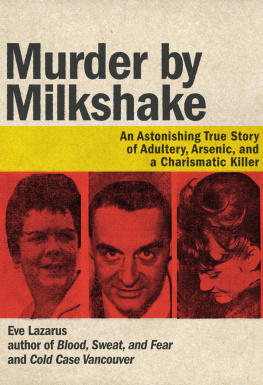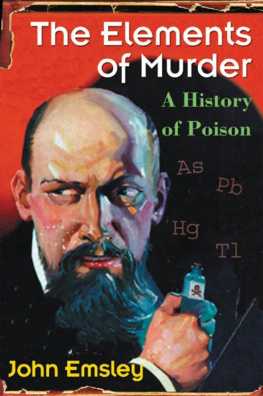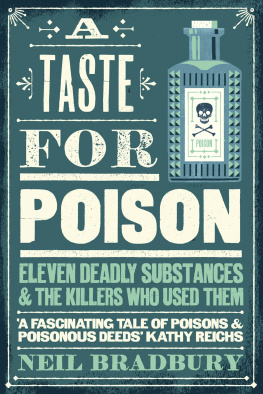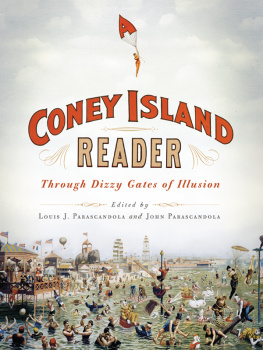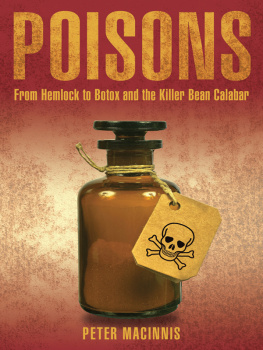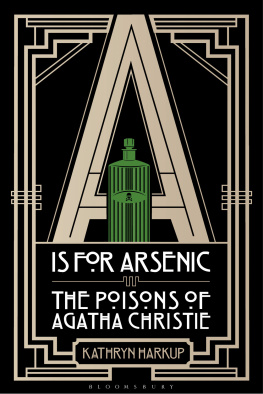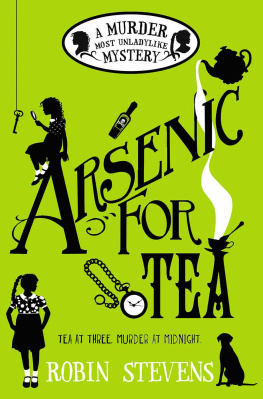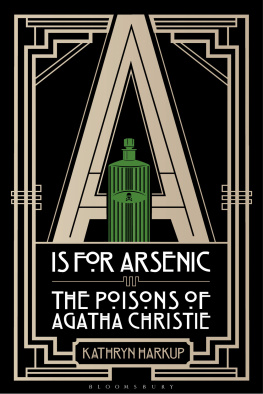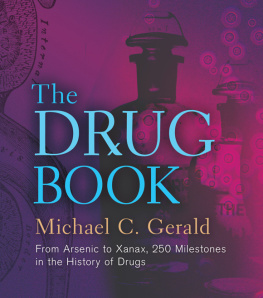Who discovered the poisonous properties of arsenic, and who first used it to murder a fellow human? The answers to these questions are lost to history. The naturally occurring arsenic sulfides realgar and orpiment were known in ancient times and were even used to some extent in medicine. The fact that they were toxic was certainly recognized, but they would not have been useful for homicidal purposes. These compounds are insoluble and colored, and so would have been difficult to administer to someone undetected. The form in which arsenic is generally used as a poison is arsenic trioxide, a white powder that has sometimes been called white arsenic. The trioxide dissolves readily in water and is colorless and tasteless, thus making it an ideal poison. The poisonous nature of arsenic trioxide and methods for making the com pound, which does not occur in nature, were certainly known by the ancient Greeks and Romans. It is easily produced, for example, by the smelting of copper ores that contain arsenic as an impurity. Roasting orpiment would also produce a white compound that would have been largely arsenic triox ide. The sodium salt of the trioxide, which had similar properties to the trioxide, could be prepared readily by heating orpiment with natural sodium carbonate.
Some accounts argue that arsenic trioxide was the poison used by Agrippina the Younger and her son, Nero, to eliminate his rivals for emperor of Rome. The evidence for such a claim, however, is not definitive, and other sub stances, such as cyanide, are also possible candidates. Plants, such as hemlock and wolfsbane, were apparently the most widely used poisons in ancient Greece and Rome. Hemlock, of course, was the poison administered by the city-state of Athens to execute Socrates, and wolfsbane was actually so frequently used as a poison that the emperor Trajan banned the growing of the plant in Roman domestic gardents.
It was not until the beginning of the fifteenth century that arsenic became popular as a poison. The most notorious name associated with poisoning in the Italian Renaissance period is the Borgia family, especially Rodrigo Borgia (who became Pope Alexander VI in 1492) and two of his children, Cesare and Lucrezia. It appears that Lucrezia has become unfairly associated with murder, however, as exemplified by the scene in Donizettis opera LucreziaBorgia where she poisons five people. In reality, Lucrezia was a pious woman who died at the age of 39, probably without poisoning anyone. There seems to be little doubt of the guilt of her father and brother, however. Cesare, in particular, probably poisoned dozens of people in the furtherance of political ends. Arsenic (probably the trioxide) was almost certainly the key ingredient in the Borgias favorite poison, called La Cantarella.
Poisoning became a formal method of assassination in Italy. By the six teenth century, there was a branch of the government of Venice that arranged for the elimination of enemies of the state. Professional poisoners worked for hire and charged fees. In Naples, beginning in the second half of the seventeenth century, a woman named Giulia Toffana (La Toffana) gained noto riety as a poisoner. Arsenic appears to have been the crucial ingredient in the poison she sold, which was frequently referred to as Aqua Toffana. When La Toffana was finally arrested and executed in 1709, she confessed (probably under torture, so the reliability of her information is questionable) to being responsible for the poisoning of some six hundred people. In the mid-sixteenth century, another woman named Hieronyma Spara (La Spara) sold an arsenic-based poison in Rome. La Spara even formed a society where she taught women how to get rid of their husbands with the use of poison.
Catherine de Medici (who married Henry II, the future king of France, in 1533) often gets the credit for bringing the Italian art of poisoning to France and using it for political gain, although this view has not gone unchallenged. There was a widespread belief in France that Italians were a devious people who got rid of their enemies by covert means. Italians were deemed experts on poisons, possessing secret knowledge of powerful toxins.
The French were themselves making significant use of arsenic and other poisons for political or personal gain by the seventeenth century. Marie- Madeleine-Margurite dAubray, marquise de Brinvilliers, was notorious for murdering members of her family to gain wealth and property in the second half of the century. She reputedly tested out her poisonous concoctions (which included arsenic) on hapless patients in a hospital in Paris, mixing the poison in the gifts of food and drink that she brought for the sick, although most likely this story is a myth. Her crimes were eventually discovered, and she was beheaded in 1676.
Another famous French poisoner of that period was Catherine Deshayes Monvoisin (La Voisin). When her husband went bankrupt, La Voisin sup ported her family by carrying out abortions, performing witchcraft, and selling love potions and poisons. Arsenic appears to have been a main ingredient in one of her poisons. Convicted of involvement in poisoning and abortion, she was tortured and burned at the stake. Poisoning had become so common in the court of Louis XIV that the king, convinced he himself was in danger, established a special commission to investigate the matter. By the time the commission finished its work in 1682, its investigation had led to the trial of 104 persons, 34 of whom were executed, with others receiving sentences of banishment or imprisonment. A royal edict issued in that year decreed that anyone convicted of supplying poison for the purpose of murder, whether or not the act resulted in fatalities, would be subject to the death penalty.
The British also tended to view poisoning as particularly associated with Italy. They even referred to the act of poisoning as Italianation, but such crimes occurred in Britain as well. By the sixteenth century, court records reveal that trials involving poisoning were occurring regularly, if not frequently. One source recorded a dozen criminal poisonings between 1571 and 1598. Not surprisingly, arsenic was one of the weapons of choice for British poisoners. In 1712 servant Elizabeth Mason used arsenic in an attempt to murder the two women who employed her. One woman died, but the other survived, and the servant was hanged.
The evidence suggests that poisoning probably reached a peak in England in the mid-nineteenth century (although poisoning was still much less fre quent than other means of homicidal violence). By far the most common poison for homicide was arsenic. In a study of 540 English criminal poisoning cases between 1750 and 1914, Katherine Watson found that arsenic (in the form of the oxide or the sulfides) was involved in 237 cases. The next most common poison, opium, was a distant second, involved in 52 cases. Watson commented, The story of poisoning in England and Wales is in many ways a chronicle of the rise and fall of arsenic."
Before 1851 there were no legal restrictions on the sale of poisons in England, so they were not difficult to obtain. It was especially easy to purchase arsenic. White arsenic was relatively cheap and was widely available, as it was commonly used to kill rats and other vermin. Arsenic was also used in medicine, such as in the popular medication known as Fowler's solution.
Although the press tended to focus attention on high-profile poisoning cases involving people of higher social status, such as physicians and middle-class women, Watson has shown that, at least in England, poisoning was primarily a crime of the poor and underprivileged. People in unhappy or abusive marriages sometimes murdered their spouses because they were unable to get divorced if they were not wealthy. Parents might murder children because they could not afford to feed and care for them, and desperate or greedy individuals might poison a relative to reap the rewards of an insurance policy. The motives for murder were many and varied.


